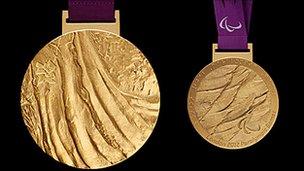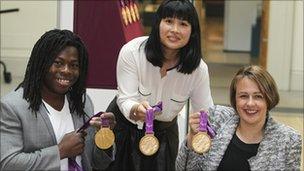London 2012: Winged Paralympic medal design unveiled
- Published
A close-up of an outstretched wing has been revealed as the design of London 2012's Paralympic medals.
The medals, designed by jewellery artist and lecturer Lin Cheung, were unveiled at the British Museum.
The design represents "Spirit in motion" and features an imagined section of the Greek goddess of victory's wing.
In 2012 more than 2,100 Paralympic medals will be presented in 502 ceremonies at the Games.
Cheung, 40, who works at London's Central Saint Martins College of Arts and Design, was one of 100 designers who took part in the competition to be chosen as the medal designer.

One side of the medal was taken from a cast of a sculpture of the goddess Nike's wing
Her medals, representing forward flight, power and lightness, were inspired by "the endurance, focus and achievement of elite Paralympic athletes".
"It was important that the medal has layers of meaning," she said, adding that her design was taken from a cast on a sculpture of the goddess Nike of Painios at the British Museum.
The original marble statue, sculpted between 425-421 BC, is in The Museum of Olympics in Ilia, Greece.
The back of Cheung's medal depicts the the heart of victory, showing the area "close to the heart of the goddess", which was chosen to reflect "inclusion and togetherness".
Dame Tanni Grey-Thompson, the 11-times British Paralympic gold medal winner, said at the launch that having competed at five sets of Games, the medal was "the most important thing - it's what people want to touch afterwards".
She praised this year's design, adding: "To have something that looks so beautiful is amazing."

Ade Adepitan [Left] and Dame Tanni [Right] praised Lin Cheung's [Centre] design
For her, the medal was the reward for all the effort of training, which she described as "dull, miserable - it's hard and you hurt".
"You want to win that medal - winning is the most amazing experience," Dame Tanni said. "Records come and go but no-one can take that medal from you."
This was echoed by fellow Paralympian athlete and medal winner Ade Adepitan, who was the deputy chair of the panel choosing the medal design. He said training for the Games was a "beautiful struggle" and that winning a medal "encapsulates that".
He said it had been "tough" choosing the design, that the panel had wanted the medal to be something the athletes "would keep dear to their hearts".
The independent panel was chaired by Sir John Sorrell and London 2012 said that they chose Cheung from a six-strong shortlist because her design "held a narrative that befitted the athletes' achievements."
The medals are among the biggest and heaviest of any summer Paralympic medals and are 85mm in diameter, 7mm thick and weigh 375g-400g.
Rio Tinto is the provider of the ore for the medals and is also a supporter of the London 2012 medals display at the British Museum.
In response to news reports earlier this year that the company's Salt Lake City copper mine, which will produce metal for the medals, is compromising air quality, its spokesman said of its upcoming expansion: "It is estimated that the Kennecott Utah Copper mine extension will have a net benefit to the emissions profile of its operations mainly due to the conversion of the existing power plant from coal to natural gas.
"Kennecott has undertaken a very public and transparent community engagement process including 10 open houses across the Salt Lake valley.
"In addition, the Kennecott staff have met with 18 environmental groups, including Utah Moms for Clean Air, over a nine-month period to specifically address the potential impact of the mine extension on the Salt Lake environment."
The first medals were made in Europe in the 15th century and the text and images were carefully integrated on both sides.
- Published16 September 2011
- Published9 September 2011
- Published23 May 2012
- Published15 September 2011